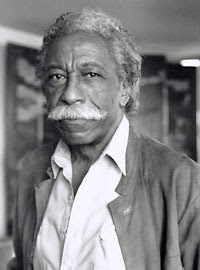Gordon Parks: Photography and Intervention
 The “Gordon Parks: Making of an Argument” exhibit at the New Orleans Museum of Art provides a fine lesson about the art of photography and socially conscious discursive interventions. The argument in question refers to “Harlem Gang Leader,” Life, November 1, 1948, pages 97-104, 106. The article was based on Park’s photographs of Leonard “Red” Jackson and members of the Midtowner’s gang, but the text was written by unnamed Life Magazine editors. There is a delicate tension between the text and the many photographs Parks shot over a period of four weeks.
The “Gordon Parks: Making of an Argument” exhibit at the New Orleans Museum of Art provides a fine lesson about the art of photography and socially conscious discursive interventions. The argument in question refers to “Harlem Gang Leader,” Life, November 1, 1948, pages 97-104, 106. The article was based on Park’s photographs of Leonard “Red” Jackson and members of the Midtowner’s gang, but the text was written by unnamed Life Magazine editors. There is a delicate tension between the text and the many photographs Parks shot over a period of four weeks.
Kalamu ya Salaam has suggested that photography is “writing with light,” and as such it demands use of visual literacy that parallels the print literacy we apply in analysis of traditional texts. “Harlem Gang Leader” illustrates that the art of “reading” in 1948 was as complex as it is in 2013.
The exhibit provides a rare opportunity to study photographs as narrative devices. The story of how the article was constructed by Life editors and how they may have altered Parks’ intentions by omitting some of the more “humanizing” photographs is fascinating. This article as text plus images may inspire us to reconsider how stories about gang violence can be angled to manipulate public opinion about causes and effects. It is impossible to know what Parks actually intended in 1948, but he does provide strong clues in Chapter 9 of Voices in the Mirror: An Autobiography (New York: Doubleday, 1990). Those clues may awaken greater interest in Richard Wright’s 1948 novella Rite of Passage and his article “Psychiatry Comes to Harlem,” Free World 12 (September 1946): 49-51. These narratives by Parks, Wright and Ellison are touchstones for measuring how far narrative has progressed or regressed as an intervention focused on young people and the American love affair with violence.
The photographic component of “Harlem Gang Leader” is a noteworthy example of how art intervenes in bringing a deeply rooted urban problem to national attention. Viewing the photographs used by the Life editors, those they rejected, and the marked-up contact sheets, one can engage in sustained study of how a narrative is complicated by a combination of the visual and the verbal. One can read “Harlem Gang Leader” online by accessing the Life Magazine archive, 1936 to 1972.